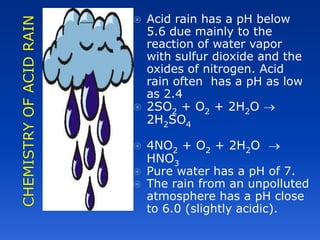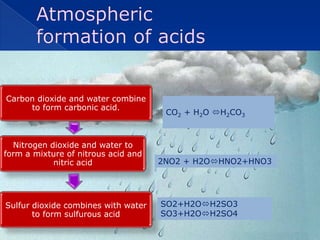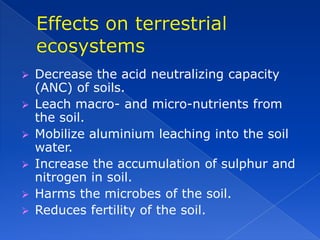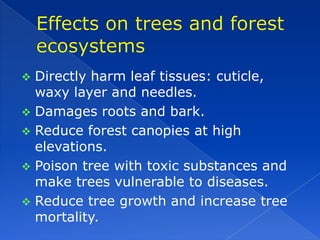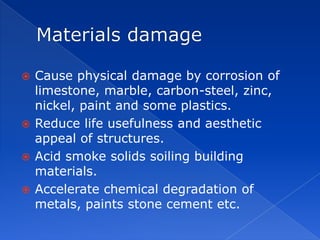Acid rain- a global ecological problem
- 2. Introduction Origin of the acid rain. Definition, forms, formation and chemistry of acid rain. Global impact of acid rain. Impact of acid rain in India. Negative environmental effects of acid rain. Beneficial effects.
- 3. Acid rain is the Acid rain is term used to Acid rain is directly becoming a global describe polluted linked air pollution. environmental rainfall (acid problem. pollution). The main acid- Acid rain is a forming pollutants transboundary are sulphur dioxide pollution problem. (SO2) and oxides of nitrogen(NOx).
- 4. In 1872, Robert Angus Smith coined the term ‘acid rain’ in his book ‘Air and Rain: The beginning of a Chemical Climatology’. Smith first found acid rain in heavily industrialized Manchester, England in 1852. He proved that acid rain has connections to pollution in atmosphere.
- 5. The rise in This results in These acidic The main driving world’s energy more sulphur pollutants factors are demands leads to dioxide and contribute acidic industrialization large scale nitrogen oxide atmospheric and urbanization. burning of coal emissions. pollution. and fossil fuels. Acid rain is caused by human activities.
- 6. Precipitation that has a pH of less than that of natural rain water. • Natural rain water has a pH range of 5-7.Normal rain is slightly acidic due to the presence of carbonic acid formed by the mixture of CO2 and rainwater. CO2 + H2O H2CO3 Acid rain water has a pH <5. • Acid rain often has a pH as low as 2.4
- 7. Acid rain Acid snow Acid fog Wet deposition Acid frost Acid dew Acidic deposition Acid hail Acid gases Dry deposition Acid dust/ particles
- 10. Acid rain has a pH below 5.6 due mainly to the reaction of water vapor with sulfur dioxide and the oxides of nitrogen. Acid rain often has a pH as low as 2.4 2SO2 + O2 + 2H2O 2H2SO4 4NO2 + O2 + 2H2O HNO3 Pure water has a pH of 7. The rain from an unpolluted atmosphere has a pH close to 6.0 (slightly acidic).
- 11. Carbon dioxide and water combine to form carbonic acid. CO2 + H2O H2CO3 Nitrogen dioxide and water to form a mixture of nitrous acid and nitric acid 2NO2 + H2OHNO2+HNO3 Sulfur dioxide combines with water SO2+H2OH2SO3 to form sulfurous acid SO3+H2OH2SO4
- 12. Acid rain is a cocktail mixture of 65% sulphuric acid,30% nitric acid and 5% hydrochloric acid. Nearly 95% of the acidity comes from atmospheric sulfur dioxide and nitrogen oxides. The contribution of sulfur gases to acid rain is 60-70%.
- 14. Forest fires Volcanoes Natural sources Lightning Wet lands-organic decay Bacterial action in soil Power generation Anthropogenic sources Factories Combustion of oil. Coal and gas Smelting of metals
- 15. Sulfuric acid Nitric acid deposition • About 25% of the acidity is deposition caused by oxides of nitrogen. • About 75% of acidity is caused • Very reactive in the by sulfuric acid in rain water. atmosphere. • combustion of fossil fuels, volcanic eruptions. Episodic Chronic Acidification-’Acid shocks’ acidification • Short intense acidic events • Low, stable acidification • Winter snowmelt, heavy rains • Loss of acid neutralizing • Suddenly changes the pH levels capacity of streams, lakes and of rivers and lakes. soil ecosystems.
- 16. North eastern United States South eastern Canada Parts of Europe-parts of Sweden, Norway and Germany. Parts of south Asia South Africa SriLanka Southern India
- 17. Taj Mahal in India Temples, murals and ancient inscriptions in Southern India Acropolis, Parthenon in Greece Renaissance buildings in Italy.
- 18. West Mayan Several minister pyramids churches Abbey in in Mexico and England cathedrals
- 19. Acid rain does not respect political boundaries. Emissions from one country may be carried by wind to a neighbouring country.
- 20. Britain • smog episodes around London, (1952) Germany • acid mists in central Germany Poland • acid cold smog (1985) Greece • Deterioration of the Parthenon in the Athens area. Italy • Damage to Venice structures Scandinavia • 15% of acid rain caused by Great-Britain • black acid snow-the Cairngorm mountains Scotland (1984) •corrosion of bells of the Utrecht Dom tower since Netherlands 1951 United states •disrupts forest ecosystems and pollutes surface waters.
- 21. Coal consumption Road traffic sources Fertilizer plants Refineries Thermal power plants Petrochemical industries Metal smelting industries pH of acid rain in Bombay and Trombay=4.45 effects pH of acid rain in Kolkata = 5.85 pH of acid rain in Chennai= 8.85 pH of acid rain in Delhi = 6.2 1
- 22. Localized effects-few kilometers range Effects decrease with increasing Direct effects distance from emission source. Effects based on concentration of pollutants in the air. Widespread effects –hundreds and thousands of kilometers. Indirect effects Secondary and tertiary effects
- 23. Atmospheric Harm or kill acid input individual fish Acidic surface Reduce population waters numbers Toxic elements Complete elimination -acid of particular fish molecules species
- 25. Affects the soil buffering capacity of watersheds. Restrict flora of aquatic macrophytes and phytoplankton. Reduce fish diversity and abundance. Cause biotic depletion. Implicate metal pollution. Limit aquatic productivity. Retard recycling of cations from sediments.
- 26. Decrease the acid neutralizing capacity (ANC) of soils. Leach macro- and micro-nutrients from the soil. Mobilize aluminium leaching into the soil water. Increase the accumulation of sulphur and nitrogen in soil. Harms the microbes of the soil. Reduces fertility of the soil.
- 27. Directly harm leaf tissues: cuticle, waxy layer and needles. Damages roots and bark. Reduce forest canopies at high elevations. Poison tree with toxic substances and make trees vulnerable to diseases. Reduce tree growth and increase tree mortality.
- 29. Cause gradual yellowing (chlorosis) of leaves. Burn leaf tissues and cause depigmentation. Disrupt the process of photosynthesis. Affect the water retaining ability of plants. Leach nutrients from plant tissues. Reduce plant germination and reproduction.
- 30. Cause extensive gill damage. Increase fish morbidity(sickness) and mortality(death). Reduce age distribution and size. Reduce growth rate and condition factor. Induce skeletal deformities in young ones. Enhance uptake of heavy metals. Cause reproductive failure.
- 31. Direct effects Indirect effects Increased morbidity Pain (sickness). Discomfort Asthma, bronchitis Aggravate heart Dry coughs disease Headaches Eye, nose and throat irritations. Mortality from lung diseases.
- 32. Cause physical damage by corrosion of limestone, marble, carbon-steel, zinc, nickel, paint and some plastics. Reduce life usefulness and aesthetic appeal of structures. Acid smoke solids soiling building materials. Accelerate chemical degradation of metals, paints stone cement etc.
- 33. Before After 1908
- 34. Sulfate aerosols diminish visibility and augment global warming. Nitrogen oxides contribute to the formation of ozone. Mercury contamination in fish. Over-fertilization of coastal waters 9 coastal eutrophication). Decrease bacterial flora and other beneficial micro-organisms. Offset mineral balance in forests, rivers, fields and lakes.
- 35. Stimulates growth of fine range grasses in iron deficient calcareous soils Improve water penetration in sodic soils. Increase micro-nutrient availability in calcareous soils.
- 36. Dr.B.Victor is a highly experienced professor, recently retired from the reputed educational institution- St. Xavier’ s College, Palayamkottai, India-627001. He was the dean of sciences, IQAC coordinator and assistant controller of examinations. He has more than 32 years of teaching and research experience He has taught a diversity of courses and guided 12 Ph.D scholars. send your comments to : [email protected]










